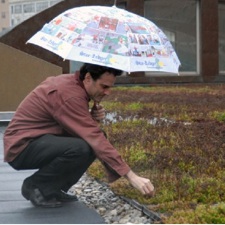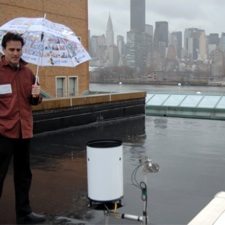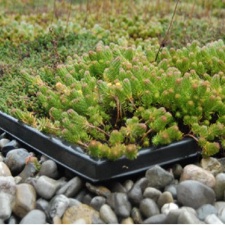
Over the Top: Data Shows "Green" Roofs Could Cool Urban Heat Islands and Boost Water Conservation
Quantifying their urban climate change-mitigating effects is an important step in getting green roofing initiatives off the ground
Feb 2, 2010 - Katie Moisse - Scientific American
 |
GROWING GREEN: Climatologist Stuart Gaffin checks the sedum plants that cover Con Edison's quarter-acre green roof.
KATIE MOISSE |
 |
A ROOF WITH A VIEW: Gaffin's sensors collect data from the control roof on top of Long Island City's Con Edison power plant.
KATIE MOISSE |
 |
| STURDY SEDUMS: These hardy plants can withstand hot summers and cold winters, making Con Edison's green roof easy to maintain. |
NEW YORK—Through the rain-pocked window of his Prius heading east on the Queensboro Bridge, Stuart Gaffin sees a black, watery sea of missed opportunities.
"Look at all those. Another 100,000 square feet!"
Gaffin, a climatologist at Columbia University's Center for Climate Systems Research, is on his way to the Con Edison power plant in Queens's Long Island City neighborhood. His view from the 40-meter-high bridge is bleak, and not just because of the rain.
"Just sitting there," he sighs. "Useless black roofs."
Since 2003 Gaffin has been studying "green" roofs—those covered with vegetation growing on top of a waterproof membrane—and their potential to mitigate urban climate change.
Like most big cities, New York City is a hot spot, and not just in the cultural sense. The solar energy absorbed into the concrete buildings and asphalt street surfaces is transformed into heat, making it significantly hotter than surrounding rural areas—a phenomenon known as the urban heat-island effect.
Green roofs can cool near-surface air temperatures by an average of 16.4 degrees Celsius per unit area—slightly behind street trees in terms of heat island mitigating potential, according to a 2006 report from the New York City Regional Heat Island Initiative. And the obvious advantage to green rooftops is that they don't take up valuable ground-level space. "Roof space is just this wasted resource," Gaffin explains. "We have somewhere between 30 and 40 square miles [in New York City]—that's 22 times Central Park!"
Although cooling heat islands is an important aspect of urban climate change mitigation, an even bigger impact could come from large-scale energy conservation. That's where green roofs hold gallons of potential. Most of the rainwater dripping off black roofs mixes with pollutants in the streets and wastewater in the sewer system as it flows to 14 water treatment facilities across the city—where it costs money and energy to clean and store. During big storms, that tainted water bypasses treatment plants altogether, pouring contaminants directly into rivers.
A four-inch-thick green roof can hold a gallon of water per square foot. If all the rooftops in the city were green, they would represent a billion gallons of storage potential. Engineering tanks to store that quantity of water is "almost inconceivable," Gaffin says. "There are so many more benefits to this type of approach," he adds. "It's stopping the problem at its source."
Although many like the idea of green roofs, the installation cost ($10 to $35 per square foot, depending on roof size, accessibility for installation, and roofing and drainage components as well as the types of plants) makes them impractical for some buildings.
"There's no argument that painting a roof white is cheaper than installing a green roof," says Chris Brunner, co-founder of New York Green Roofs, LLC. But Brunner says when it comes to reducing storm water runoff and improving air quality, white roofs just don’t stack up.
That's why Gaffin is visiting Con Edison's quarter-acre green roof on this rainy afternoon. Using sensors developed for agricultural research, Gaffin is turning city roofs, like this one on top of New York City's biggest energy provider, into field sites where he can measure the energy and water absorption properties that dictate surface temperature and water storage.
Con Edison's sprawling green roof is covered with sedum plants, hardy succulents that thrive with little maintenance, if any. It is mostly green, except for a raised level that is black with a patch of white. This raised section is used as a control: Energy sensors probe the black and white surfaces to measure their surface temperatures and compare it with those of the planted area, while metered troughs collect water running off the two surfaces. Today, rainwater is cascading down the sides of the control roof.
In a report published in the journal Sensors last year, Gaffin provided sample data collected from five green roof research stations in the New York City area (including Con Edison's) constituting a prototypical "urban meteorological network". The results showed that the mitigating effects of green roofs do exist, and can be accurately measured. Gaffin suggests that measuring these effects will be important for urban policymakers comparing the costs and benefits of different alleviation strategies.
But the most meaningful measure of the Con Edison roof's efficiency for Gaffin is not numeric. "It's fun to hear [the engineers] say they don't have to replace the filters on the air-conditioning system as much anymore," he says, explaining that, at least anecdotally, the building's air quality has noticeably improved since the roof was installed in 2008. Ultimately he hopes to quantitatively measure the quality of the air and water on the green roof’s surface.
Gaffin says unwarranted fears of waterlogged, leaky roofs also stand in the way of buildings roofing green. "The Museum of Modern Art got convinced to try it, but they were very nervous about it because they were thinking about their Picassos," he jokes. But he insists that green roofs are the safest, most protective, longest lasting and least risky roofs you can get. "Black roofs," he says with a grimace, "they're not even good roofs!"
Several rooftops around the city have gone green, including ones covering schools, museums and even Silvercup Studios in Queens—home of The Sopranos set. The Mayor's office roof has gone white—better than black in the summer but arguably worse in the winter, Gaffin says. And whereas white roofs may help cool cities, according to a study recently accepted for publication in Geophysical Research Letters, they don't do anything for storm water runoff.
In addition to their measurable environmental effects, Gaffin says biophilia—the love of living systems—and the therapeutic value of natural spaces is another, more qualitative incentive for green roofs. "I visited my mother-in-law recently in the hospital and she was looking onto the bleakest roof," he says, describing the blighted, garbage-strewn surface. "And I was thinking: 'Now if that was a green roof…'"

|





